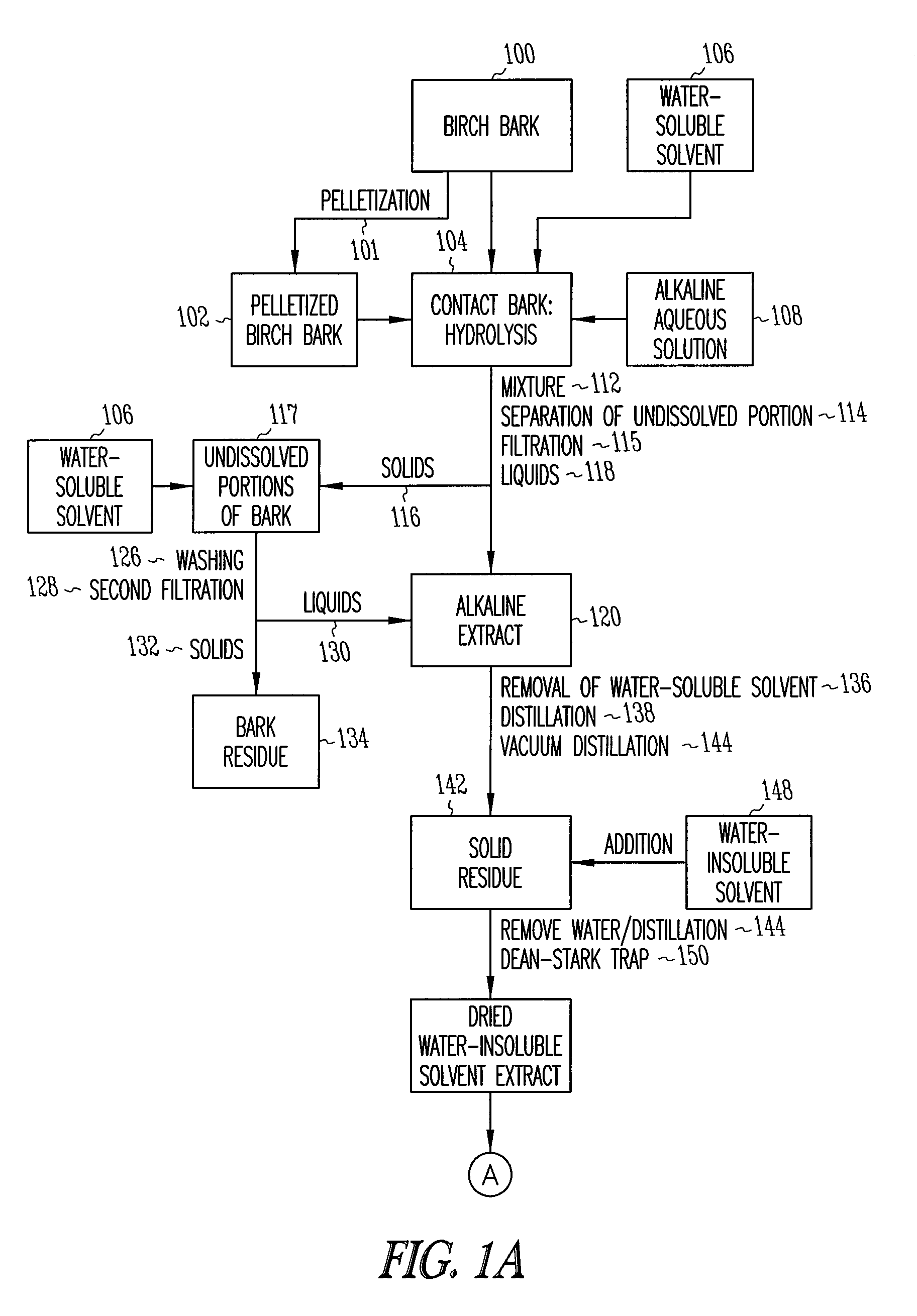Depolymerization extraction of compounds from birch bark
a technology of birch bark and organic compounds, which is applied in the direction of biocide, plant/algae/fungi/lichens, hair cosmetics, etc., can solve the problems of ineffective extraction of other natural occurring triterpenoid derivatives such as betulin-3-caffeate, betulinic acid, etc., and achieves the effect of increasing the yield of betulin
- Summary
- Abstract
- Description
- Claims
- Application Information
AI Technical Summary
Benefits of technology
Problems solved by technology
Method used
Image
Examples
example 1
Separate Stages of Depolymerization (NaOH) and Extraction
Preparation of Birch Bark Hydrolyzate
[0096]Pressed outer birch bark (15 kg) was added in portions to a solution of NaOH (3.5 kg, 87.5 mol) in H2O (1.75 L) and i-PrOH (150 L) at 50° C. The reaction mixture was refluxed for 3 hrs and then filtered. The solid portion recovered from the filter was refluxed with i-PrOH (60 L) for 0.5 hr and again filtered. The procedure was repeated a third time with 60 L of i-PrOH. The isopropanol extracts were combined and the solvent was evaporated yielding a solid residue I (7.9 kg). The solid residue I comprises the solid residue 142 of the preferred embodiment shown in FIG. 1.
Composition of I
[0097]
18-Hydroxyoctadec-9-enoic acid, sodium salt6.4%Threo-9,10,18-trihydroxyoctadecanoic acid, sodium salt6.7%18-Hydroxy-9,10-epoxyoctadecanoic acid, sodium salt20.5%22-Hydroxydocosanoic acid, sodium salt8.6%Lupeol2.8%Betulin43%Betulinic acid, sodium salt3.0%Other ω-hydroxy fatty acids, sodium salts9.0%
P...
example 2
Separate Stages of Depolymerization (KOH) and Extraction
Preparation of Birch Bark Hydrolyzate
[0105]Pressed outer birch bark (15 kg) was added in portions to a solution of KOH (4.2 kg, 75 mol) in H2O (2.25 L) and i-PrOH (80 L) at 50° C. The reaction mixture was refluxed for 3 hrs and then filtered. The solid residue was extracted twice with isopropanol (40 L). The isopropanol extracts were combined and the solvent evaporated, yielding a solid residue VII (10 kg). The solid residue VII comprises the solid residue 142 of the preferred embodiment shown in FIG. 1.
Composition of VII
[0106]
18-Hydroxyoctadec-9-enoic acid, potassium salt5.8%Threo-9,10,18-trihydroxyoctadecanoic acid, potassium salt11.5%18-hydroxy 9,10-epoxyoctadecanoic, potassium salt15.7%22-Hydroxydocosanoic acid, potassium salt7.4%Lupeol3.4%Betulin44%Betulinic acid, potassium salt3.0%Other ω-hydroxy fatty acids, potassium salts9.1%
Preparation of Crude Neutral Organic Compounds Extract
[0107]The solid residue VII was added to ...
example 3
One-Pot Depolymerization (NaOH) and Extraction
Preparation of Crude Neutral Organic Compounds Extract
[0113]Pressed outer birch bark (1 kg) was added in portions to a solution of NaOH (230 g, 5.75 mol) in H2O (90 ml) and EtOH (2.5 L) at 70° C. The reaction mixture was refluxed with good stirring for 1 hr. Xylenes (6 L) was then added, and a mixture of EtOH and H2O in xylenes (3.6 L) was distilled from the reaction mixture. Distillation was continued until the temperature of the vapors reached 133° C. An additional amount of H2O (15 ml) was distilled from the reaction mixture using a Dean-Stark receiver. The reaction mixture was filtered at 100° C. The solid residue was added to xylenes (3 L) and refluxed for 1 hr. Water (15 ml) was distilled from the reaction mixture using a Dean-Stark receiver, and the reaction mixture was filtered at 100° C. Washing of the solid residue with xylenes (3 L) was repeated. The combined xylenes extracts was evaporated and the residue dried in vacuum at 8...
PUM
| Property | Measurement | Unit |
|---|---|---|
| boiling point | aaaaa | aaaaa |
| temperature | aaaaa | aaaaa |
| temperature | aaaaa | aaaaa |
Abstract
Description
Claims
Application Information
 Login to View More
Login to View More - R&D
- Intellectual Property
- Life Sciences
- Materials
- Tech Scout
- Unparalleled Data Quality
- Higher Quality Content
- 60% Fewer Hallucinations
Browse by: Latest US Patents, China's latest patents, Technical Efficacy Thesaurus, Application Domain, Technology Topic, Popular Technical Reports.
© 2025 PatSnap. All rights reserved.Legal|Privacy policy|Modern Slavery Act Transparency Statement|Sitemap|About US| Contact US: help@patsnap.com



